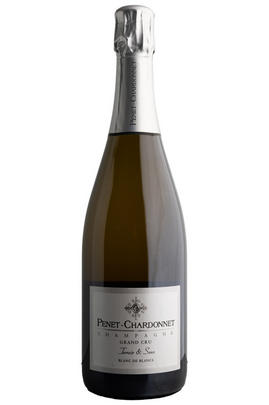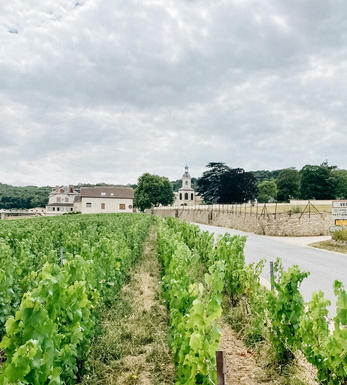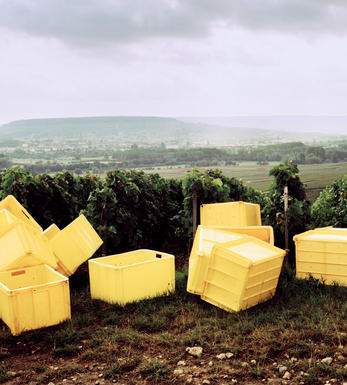
Champagne Penet-Chardonnet, Terroir & Sens, Blanc de Blancs, Grand Cru, Extra Brut

Critics reviews
Bottled May 2017, disgorged October 2021.
Attractive nutty aromas, developed and oxidative fruit on the palate – very Selossian. Intense autolysis, modern, much more characterful than a standard NV.
Drink 2020 - 2026
Richard Hemming MW, JancisRobinson.com (February 2023)
Aromas of dried apricots, salted almonds, chalk, ginger snaps and dried spices. Medium-bodied with sleek bubbles and bright acidity. Some spicy ginger character to this. Dry. 100% Chardonnay. 2016 base wine. 5.2g/l dosage.
Drink now
James Suckling, JamesSuckling.com (July 2022)
About this WINE

Champagne Penet-Chardonnet
Champagne Penet-Chardonnet has 400 years of winemaking history behind it. The estate spans six hectares, spread over 30 small plots across Verzy and Verzenay in the Montagne de Reims.
Located in the north-eastern extremity of the region, this land is 100% Grand Cru, and is home to some of the best Pinot Noir vineyards in all of Champagne. The Penet family farms their estate with the utmost care for nature, using sustainable and organic methods.
The estate is now run by fourth generation winemaker Alexandre Penet and his wife Martine, who have redefined the house style since taking over in 2009. Alexandre vinifies all crus separately, bottling the best sites as single lieu dits. These wines are set to become some of the most desired in the region: detail, expressive and made with precision, they are totally distinctive in personality.

Champagne
Our wine buyers leave no stone unturned in their quest to find the best Champagnes, and Berry Bros. & Rudd takes particular pride in its eclectic range of artisan Champagnes that represent a real sense of terroir, original winemaking, labour-intensive viticulture (often organic/biodynamic) and the uncompromising excellence of the end product.
How Champagne is made
In 1668, in the village of Hautvillers, the monk turned cellar master, Dom Pérignon, is said to have discovered how to make sparkling wine; while the same technique is used all over the world today, the region of Champagne continues to make some of the finest.
So what makes wine sparkle? Adding a solution of sugar and yeast to a white wine starts another fermentation in the bottle which results in the bubbles. Once the yeasts have done their job, a sediment known as ‘lees’ collects on the side of the bottle; contact with this deposit during maturation gives the wine its characteristic flavours of freshly-baked bread, toast and biscuit. Once this sediment is isolated (remuage) and removed (dégorgement), the Champagne is topped up with a sugar solution to make it dry or sweet
The Champagne Wine Region
Champagne is the most northerly wine region in France and is situated north-east of Paris. There are three main vineyard areas: Côte des Blancs, Vallée de la Marne and Montagne de Reims.
Ripeness of the grapes is often a problem, which is one reason why a blend of grape varieties is usually used: the white Chardonnay to give fruit and elegance, and two reds – Pinot Noir (particularly to provide a ‘backbone’) and Pinot Meunier.
In Champagne there are around 15,000 growers and 290 Champagne houses. Traditionally, growers have sold their grapes to the Champagne houses which account for 70 percent of production and 90 percent of exports. Recently, increasing numbers of growers are making growers’ Champagnes themselves, using their own grapes.
The Champagne houses used to be organized into a Syndicat des Grandes Marques, which had 28 members, not all of them of equal quality. That has now been superseded by the Club des Grandes Marques, with 24 participants: Ayala, Billecart-Salmon, Bollinger, Canard- Duchêne, Deutz, Dom Pérignon, Heidsieck & Co. Monopole, Henriot, Krug, Lanson, Laurent-Perrier, Moët & Chandon, G.H. Mumm, Perrier Jouët, Joseph Perrier, Piper-Heidsieck, Pol Roger, Pommery, Ch. & A Prieur, Louis Roederer, Ruinart, Salon, Taittinger, Veuve Clicquot-Ponsardin.
Champagne Styles
Vintage Champagne
Made exclusively from grapes grown in a single year, this is produced only in the best years, and is released at about six years of age.
Non-Vintage Champagne
Most of the Champagne produced today is Non-Vintage, comprising the blended product of grapes from multiple vintages. Typically grapes from a single-year vintage will form the base of the blend, ranging from 15 percent to up to 40 percent.
Rosé Champagne
Typically light in colour, rosé Champagne is produced either by leaving the clear juice of black grapes to macerate on its skins for a brief time (known as saigneé), or by adding a small amount of Pinot Noir red wine to the sparkling wine cuvée. The saigneé method is more elaborate and costly, requiring highly-skilled winemaking, hence only a few houses still use it – among them Laurent Perrier and Louis Roederer.
Luxury (Prestige) Cuvée
Top of the range, this is vintage-dated. Famous examples include Louis Roederer's Cristal, Laurent-Perrier's Grand Siècle, Moët & Chandon's Dom Pérignon, Duval-Leroy's Cuvée Femme and Pol Roger's Cuvée Sir Winston Churchill.
Demi-Sec (Rich) Champagne
Demi-Sec or Rich is a medium-dry to medium-sweet style which occupies the other end of the spectrum from the standard dry "Brut" style. Brut Natural or Brut Zéro contains less than three grams of sugar per litre, Extra Brut has less than six grams of sugar per litre, and Brut less than 12 grams of sugar per litre.
Recently Disgorged Champagne
R.D. (Recently Disgorged) style was introduced for the first time by Madame Bollinger in 1961, on the 1952 Bollinger Grande Année vintage. Late disgorgement allows the Champagne to retain its freshness, vivacity and fruity expression, despite the ageing.
Blanc de Blancs Champagne
Blanc de Blancs denotes a Champagne made exclusively from Chardonnay grapes.
Blanc de Noirs Champagne
Blanc de Noir Champagnes are made exclusively from black grapes, Pinot Noir (typically) and Pinot Meunier grapes. Bollinger's prestige cuvée Vieilles Vignes Françaises is the lead example.

Chardonnay
Chardonnay is often seen as the king of white wine grapes and one of the most widely planted in the world It is suited to a wide variety of soils, though it excels in soils with a high limestone content as found in Champagne, Chablis, and the Côte D`Or.
Burgundy is Chardonnay's spiritual home and the best White Burgundies are dry, rich, honeyed wines with marvellous poise, elegance and balance. They are unquestionably the finest dry white wines in the world. Chardonnay plays a crucial role in the Champagne blend, providing structure and finesse, and is the sole grape in Blanc de Blancs.
It is quantitatively important in California and Australia, is widely planted in Chile and South Africa, and is the second most widely planted grape in New Zealand. In warm climates Chardonnay has a tendency to develop very high sugar levels during the final stages of ripening and this can occur at the expense of acidity. Late picking is a common problem and can result in blowsy and flabby wines that lack structure and definition.
Recently in the New World, we have seen a move towards more elegant, better- balanced and less oak-driven Chardonnays, and this is to be welcomed.


Buying options
Add to wishlist
Description
The Terroir & Sens Blanc de Blancs from Champagne Penet-Chardonnet is a rare gem, stemming from a Grand Cru village known almost exclusively for Pinot Noir. This wine demonstrates the richness, complexity and minerality of the terroir.
The nose is vinous, smoky and reminiscent of white Burgundy, helped by its time in used barrel. The palate is detailed, with crispy and supple white fruit, alongside notes of cardamom, saffron, and patisserie. There’s a fine, minerally charged mousse.
Drink now until 2035
Davy Żyw, Senior Buyer, Berry Bros. & Rudd (September 2022)
wine at a glance
Delivery and quality guarantee